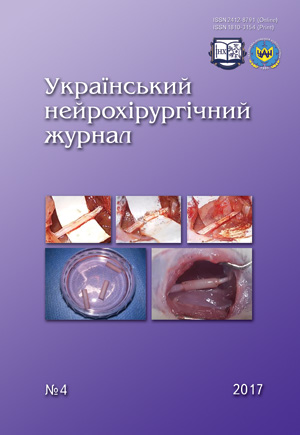Features of the diagnosis of defeat of the nervous system of yeast-like fungi of the genus Candida spp., Cryptococcus spp.
DOI:
https://doi.org/10.25305/unj.114306Keywords:
mycosis, nervous system, meningoencephalitis, Cryptococcus, microscopy, cerebrospinal fluid, Cryptococcal antigen, diagnosticsAbstract
Objective. To carry out a comparative analysis of the informative value of different methods of diagnosing the nervous system damage due to Candida and Cryptococcus spp.
Materials and methods. The article presents the results of a complex mycological examination of 170 patients with neuroinfection treated in the Department of Intensive Care and Detoxification of Gromashevsky Institute of Epidemiology and Infectious Diseases. The study was conducted during hospitalization, on the 14th, 21st day of treatment. The cryptococcal antigen in CMP was detected using latex agglutination reaction with qualitative and semi-quantitative CALAS®, Meridian Bioscience, Europe test system.
Results. Cryptococcal meningoencephalitis (CrMe) was diagnosed in 15.88% (38.46% among HIV-infected), Candida meningoencephalitis (CME) in 3.53% of patients with neuroinfection. General clinical findings of the cerebrospinal fluid (CSF) are not informative enough, but do not fully reflect the inflammatory process in the nervous system, especially in HIV-infected and cancer patients. CSF microscopy and the culture method confirm the diagnosis of CrMe, CME only in 66.67% patients with HIV-negative status and in 33.33% HIV-infected patients. The article presents the results of CSF study by latex agglutination (RLA) for detecting cryptococcal antigen (CrAg).
Conclusions. RLA for detecting CrAg in CSF should be considered as the basic method for early diagnosis of CrMe. In 71.43% HIV-patients, RLA CrAg in CSF was detected by negative microscopy. In CME patients PCR should be considered as the most informative and sensitive diagnostic method in difficult cases.
References
1. Hlumcher FS, Klimko MM, Shyrobokov VP, Fomin PD, Tkachyk IP, Holubovs’ka OA, Pidhirnyy YaM. Diahnostyka ta likuvannya mikoziv u viddilennyakh intensyvnoyi terapiyi. Metodychni rekomendatsiyi. Kyiv: [publisher unknown]; 2013. Ukrainian.
2. Andes DR, Safdar N, Baddley JW, Playford G, Reboli AC, Rex JH, Sobel JD, Pappas PG, Kullberg BJ; Mycoses Study Group. Impact of treatment strategy on outcomes in patients with candidemia and other forms of invasive candidiasis: a patient-level quantitative review of randomized trials. Clin Infect Dis. 2012 Apr;54(8):1110-22. [CrossRef] [PubMed]
3. Blot S, Vandewoude K. Management of invasive candidiasis in critically ill patients. Drugs. 2004;64(19):2159-75. Review. [PubMed]
4. Charles PE, Dalle F, Aube H, Doise JM, Quenot JP, Aho LS, Chavanet P, Blettery B. Candida spp. colonization significance in critically ill medical patients: a prospective study. Intensive Care Med. 2005 Mar;31(3):393-400. [CrossRef] [PubMed]
5. Liu CY, Huang LJ, Wang WS, Chen TL, Yen CC, Yang MH, Hsiao LT, Liu CY, Chen PM, Chiou TJ. Candidemia in cancer patients: impact of early removal of non-tunneled central venous catheters on outcome. J Infect. 2009 Feb;58(2):154-60. [CrossRef] [PubMed]
6. Murthy JM. Fungal infections of the central nervous system: the clinical syndromes. Neurol India. 2007 Jul-Sep;55(3):221-5. [CrossRef] [PubMed]
7. Nalintya E, Kiggundu R, Meya D. Evolution of Cryptococcal Antigen Testing: What is new? Curr Fungal Infect Rep. 2016 Jun;10(2):62-67. [CrossRef] [PubMed] [PubMed Central]
8. Rauchway AC, Husain S, Selhorst JB. Neurologic presentations of fungal infections. Neurol Clin. 2010 Feb;28(1):293-309. [CrossRef] [PubMed]
9. Saha DC, Xess I, Biswas A, Bhowmik DM, Padma MV. Detection of Cryptococcus by conventional, serological and molecular methods. J Med Microbiol. 2009 Aug;58(Pt 8):1098-105. [CrossRef] [PubMed]
10. Scully EP, Baden LR, Katz JT. Fungal brain infections. Curr Opin Neurol. 2008 Jun;21(3):347-52. [CrossRef] [PubMed]
11. Zaragoza O, Casadevall A. Monoclonal antibodies can affect complement deposition on the capsule of the pathogenic fungus Cryptococcus neoformans by both classical pathway activation and steric hindrance. Cell Microbiol. 2006 Dec;8(12):1862-76. [CrossRef] [PubMed]
Downloads
Published
How to Cite
Issue
Section
License
Copyright (c) 2017 Elena L. Panasiuk, Darja V. Govorova, Viktor I. Matyach, Sergiy P. Borshchov, Tatyana L. Tokunova, Nataliya S. Trembachova

This work is licensed under a Creative Commons Attribution 4.0 International License.
Ukrainian Neurosurgical Journal abides by the CREATIVE COMMONS copyright rights and permissions for open access journals.
Authors, who are published in this Journal, agree to the following conditions:
1. The authors reserve the right to authorship of the work and pass the first publication right of this work to the Journal under the terms of Creative Commons Attribution License, which allows others to freely distribute the published research with the obligatory reference to the authors of the original work and the first publication of the work in this Journal.
2. The authors have the right to conclude separate supplement agreements that relate to non-exclusive work distribution in the form of which it has been published by the Journal (for example, to upload the work to the online storage of the Journal or publish it as part of a monograph), provided that the reference to the first publication of the work in this Journal is included.









